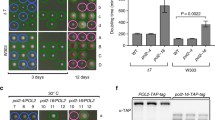Summary
A discrete class of strains of Saccharomyces cerevisiae, able to utilize, highly efficiently, exogenous deoxythymidine-5′-monophosphate (dTMP), was found to be sensitive to concentrations >10 μM dTMP in an otherwise complete growth medium. Excess dTMP is cytostatic and cytotoxic: 90% of exponentially growing cells lose colony forming ability within 1 h of exposure to excess dTMP in a growth medium. Uptake of dTMP, adenine, histidine, and leucine does occur during this thymidylate excess death (TED). dTMP is anabolized to higher phosphorylated nucleotides and catabolized to thymidine intracellularly. DNA synthesis is blocked under TED-conditions but not RNA and protein biosynthesis.
Similar content being viewed by others
Abbreviations
- dTMP:
-
deoxythymidine-5′-monophosphate
- dTDP:
-
deoxythymidine-5′-diphosphate
- dTTP:
-
deoxythymidine-5′-triphosphate
- dThd:
-
deoxythymidine
- tmp :
-
genetic symbol for dTMP-auxotrophy
- TMP :
-
genetic symbol for dTMP-prototrophy
- (tlr):
-
symbol for the phenotype of a yeast strain to efficiently utilize exogenous dTMP
References
Brendel M, Langjahr UG (1974) Thymineless death in a strain of Saccharomyces cerevisiae auxotrophic for deoxythymidine-5′-monophosphate. Mol Gen Genet 131:351–358
Brendel M, Fäth WW, Laskowski W (1975) Isolation and characterization of mutants of Saccharomyces cerevisiae able to grow after inhibition of dTMP synthesis. In: Prescott DM (ed) Methods in cell biology, vol. XI. Academic Press, New York San Francisco London, pp 287–294
Chapman AG, Fall L, Atkinson DE (1971) Adenylate energy charge in Escherichia coli during growth and starvation. J Bacteriol 108:1072–1086
Fäth WW (1973) Untersuchungen zur spezifischen DNS-Markierung mit radioaktiven Desoxythymidin-5′-Monophosphat in Saccharomyces cerevisiae. Thesis of diploma, J.W. Goethe-university Frankfurt/Main
Fäth WW (1980) Studien zur Aufnahme von exogenem Desoxythymidin-5′-Monophosphat in der Hefe Saccharomyces cerevisiae. Ph D Thesis, J.W. Goethe-university Frankfurt/Main
Fäth WW, Brendel M (1974a) Specific DNA-labelling by exogenous thymidine-5′-monophosphate in Saccharomyces cerevisiae. Mol Gen Genet 131:57–67
Fäth WW, Brendel M (1974b) Isolation and characterization of mutants of Saccharomyces cerevisiae auxotrophic and conditionally auxotrophic for 5′-dTMP. Z Naturforsch 29c:733–738
Fäth WW, Brendel M (1975a) An improved assay of UV-induced thymine-containing dimers in Saccharomyces cerevisiae. Z Naturforsch 30c:804–810
Fäth WW, Brendel M (1975b) UV-induction of thymine-containing dimers in Saccharomyces cerevisiae. Z Naturforsch 30c:811–817
Fäth WW, Brendel M (1976) Isolation and properties of yeast mutants with highly efficient thymidylate utilization. Z Naturforsch 31c:468–478
Fäth WW, Brendel M, Laskowski W, Lehmann-Brauns E (1974) Economizing DNA-specific labelling by exogenous deoxythymidine-5′-monophosphate in Saccharomyces cerevisiae. Mol Gen Genet 132:335–345
Ferguson LR, Cox BS (1974) Excision of base accompanying the excision of dimers from DNA of UV-irradiated yeast. Mol Gen Genet 135:87–90
Fleer R, Brendel M (1979) Formation and fate of cross-links induced by polyfunctional anticancer drugs in yeast. Mol Gen Genet 176:41–52
Grivell AR, Jackson JF (1968) Thymidine kinase: Evidence for its absence from Neurospora crassa and some other microorganisms, and the relevance of this to the specific labelling of deoxyribonucleic acid. J Gen Microbiol 54:307–317
Hartman SC (1970) Purines and pyrimidines. In: Greenberg DM (ed) Metabolic pathways vol. 4. Academic Press, New York London, pp 1–58
Kit S (1970) Nucleotides and nucleic acids. In: Greenberg DM (ed) Metabolic pathways vol. 4. Academic Press, New York London, pp 70–252
Kircher M, Fleer R, Ruhland A, Brendel M (1979) Biological and chemical effects of mustard gas in yeast. Mut Res 63:273–289
Langjahr UG, Hartmann EM, Brendel M (1975) Nucleic acid metabolism in yeast. I. Inhibition of RNA and DNA synthesis by high concentrations of exogenous deoxythymidine-5′-monophosphate in 5′-dTMP low requiring strains. Mol Gen Genet 143:113–118
Nexø BA (1975) Ribo- and deoxyribonucleoside triphosphate pools in synchronized populations of Tetrahymena pyriformis. Biochim Biophys Acta 378:12–17
Ohkawa T (1976) Relationship between synthesis of deoxyribonucleic acid and thymidine triphosphate pool in Escherichia coli K12. Eur J Biochem 61:81–91
Author information
Authors and Affiliations
Additional information
Communicated by F. Kaudewitz
Rights and permissions
About this article
Cite this article
Toper, R., Fäth, W.W. & Brendel, M. Nucleic acid metabolism in yeast II. Metabolism of thymidylate during thymidylate excess death. Molec. Gen. Genet. 182, 60–64 (1981). https://doi.org/10.1007/BF00422767
Received:
Issue Date:
DOI: https://doi.org/10.1007/BF00422767




